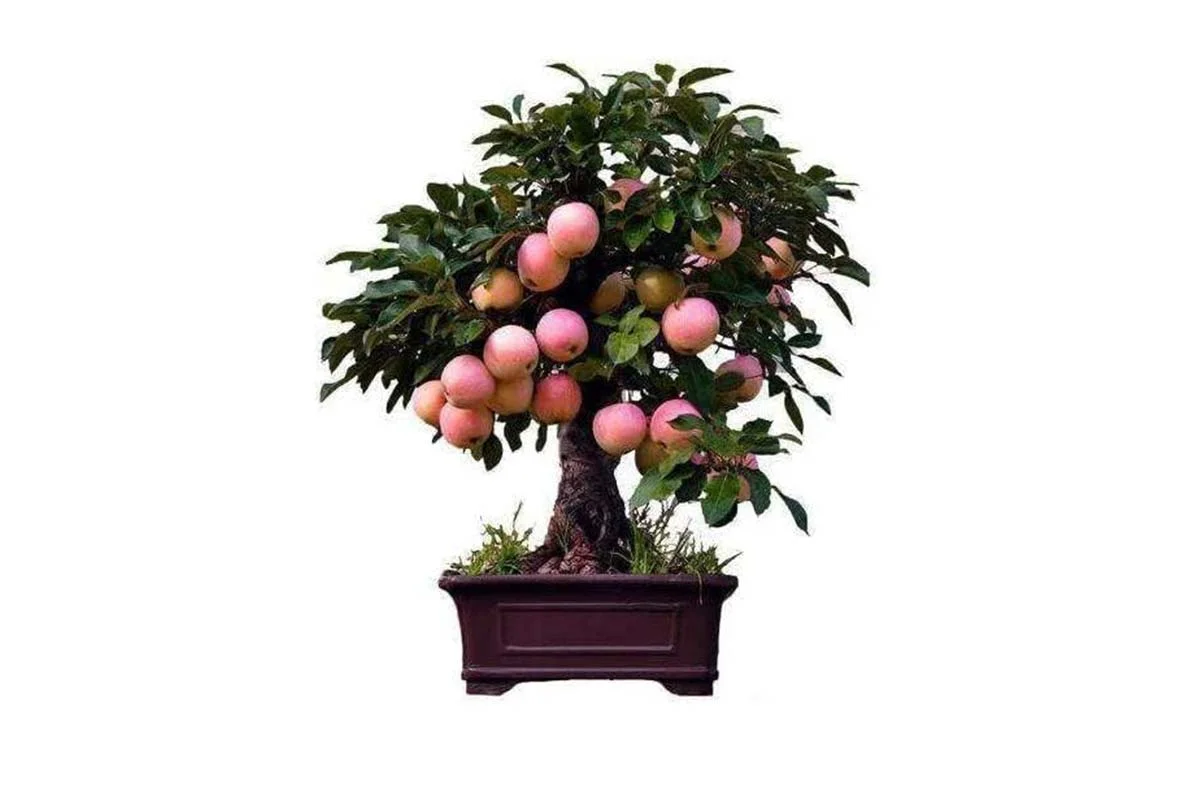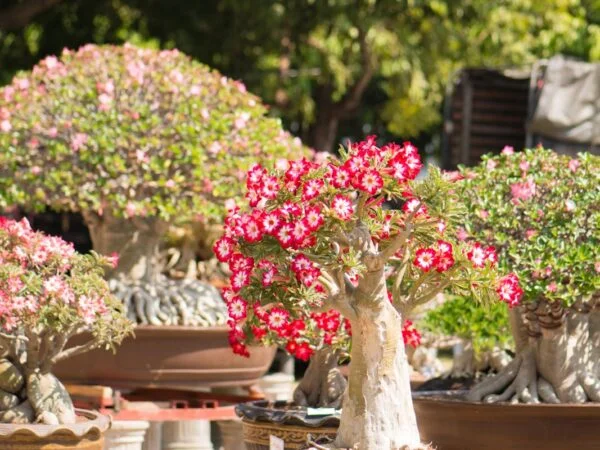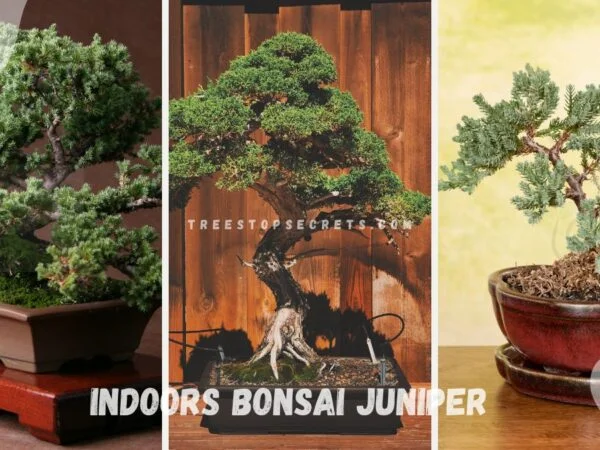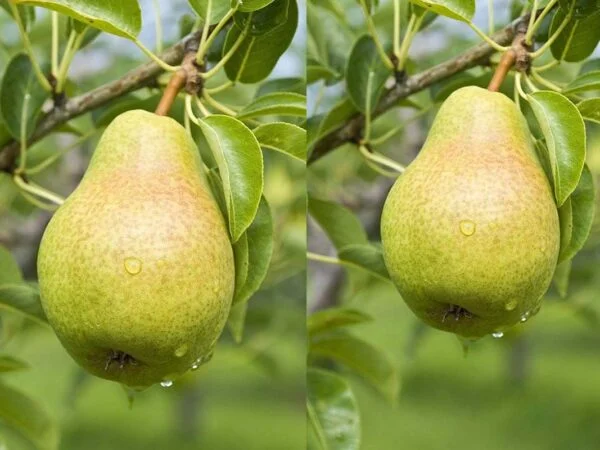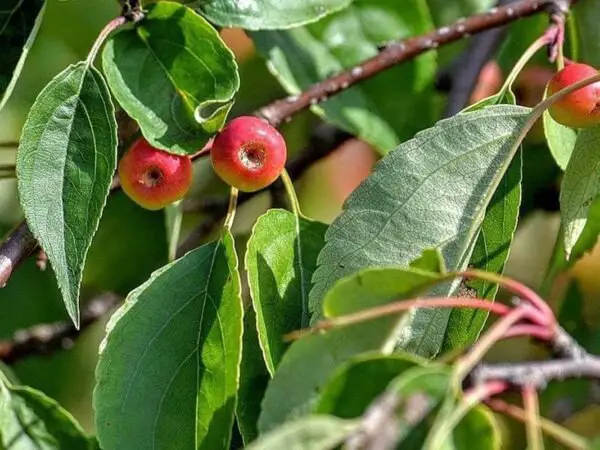A Bonsai Apple Tree is a miniature version of a standard apple tree, grown in a small container using traditional bonsai techniques. This tree is pruned and shaped to maintain a small size while still producing apples, albeit on a smaller scale.
Bonsai apple trees are a perfect blend of horticulture and artistry. They are carefully shaped and pruned to mimic the larger versions of apple trees, creating a miniature orchard experience at home. These trees typically produce small apples and have blossoms just like their full-sized counterparts. They are popular among bonsai enthusiasts because of their ability to flower and bear fruit in confined spaces, making them both decorative and functional.
To successfully grow a bonsai apple tree, it's essential to choose the right variety that can be trained and pruned into a compact form. Common varieties include the 'Crabapple' and 'Dwarf Apple' species. These types are known for their ability to thrive in small pots and their resilience to pruning.
Tips for Growing a Bonsai Apple Tree:
- Choose the Right Variety: Opt for dwarf or crabapple varieties as they are easier to maintain in bonsai form.
- Use Proper Soil: A well-draining bonsai soil mix is crucial to prevent root rot and ensure proper growth.
- Regular Pruning: Keep the tree's size in check by regularly pruning branches, roots, and leaves.
- Adequate Watering: Maintain a consistent watering schedule, keeping the soil moist but not waterlogged.
- Fertilization: Use a balanced fertilizer to provide necessary nutrients, especially during the growing season.
Table: Bonsai Apple Tree Care Tips
| Care Aspect | Description |
|---|---|
| Watering | Water regularly; avoid waterlogging. |
| Pruning | Prune in early spring to shape the tree. |
| Soil | Use a well-draining bonsai soil mix. |
| Fertilizing | Apply balanced fertilizer during the growing season. |
| Lighting | Place in bright, indirect sunlight. |
My Experience with Bonsai
I have always been fascinated by the art of bonsai, and my journey began when I decided to grow a bonsai apple tree. These miniature trees not only bring a sense of tranquility to my home but also serve as a rewarding and engaging hobby. The process of nurturing a bonsai apple tree has taught me patience and dedication, as it involves careful attention to detail and an understanding of the tree's needs.
Bonsai apple trees are a popular choice among bonsai enthusiasts, and for good reason. Their beautiful weeping habit makes them ideal for growing in the limited space of a bonsai pot. With proper care, they can produce an impressive display of fruits and flowers that lasts for many years (Bonsai Resource Center).
Why Choose Apple Trees
Choosing apple trees for bonsai cultivation has many advantages. These moderately quick-growing hardwood trees are suitable for creating elegant and dramatic pieces of visual art within one's lifetime. Their attractive foliage and bark enhance the overall aesthetic of any bonsai display (Gardener's Path).
In addition to their beauty, bonsai apple trees offer the unique opportunity to bear fruit. While it typically takes about 8-9 years for a bonsai apple tree to produce fruit if started from a sapling, the reward is well worth the wait. Typically, these trees bear fruit in autumn, similar to their larger counterparts in the ground. However, due to the stressful conditions of growing in a small container, it may take longer for bonsai trees to produce fruit (Gardener's Path).
Here is a summary of key features of bonsai apple trees:
| Feature | Description |
|---|---|
| Growth Rate | Moderately quick-growing |
| Fruit Production Time | 8-9 years from sapling |
| Aesthetic Qualities | Attractive foliage and bark |
| Ideal Growing Conditions | Limited space in bonsai pots |
Bonsai apple trees combine artistry with the practical benefit of fruit production, making them an ideal choice for any bonsai enthusiast.
Growing Conditions
Creating the right environment for my bonsai apple tree has been crucial for its growth and overall health. Here are the key aspects of growing conditions that I discovered are essential.
Ideal Soil Requirements
Bonsai apple trees thrive in well-draining soil that is rich in organic matter. I found that a suitable potting mix consists of two parts loam, one part peat moss, and one part sand. This combination allows for proper drainage while retaining adequate moisture. Before planting, it's important to lightly moisten the soil to prevent root rot.
| Soil Component | Ratio |
|---|---|
| Loam | 2 parts |
| Peat Moss | 1 part |
| Sand | 1 part |
Perfect Sunlight Exposure
The position of my bonsai apple tree has a significant impact on its growth. I learned that it's best to place the tree in an area that receives full sun for at least six hours each day. In hotter climates, providing some afternoon shade can help protect it from excessive heat. The tree can tolerate temperatures as low as 50 degrees Fahrenheit, but I ensure it is protected from freezing temperatures.
| Sunlight Needs | Duration |
|---|---|
| Full Sun | 6 hours minimum |
| Afternoon Shade | Recommended in hot climates |
| Minimum Temperature | 50°F |
Watering Guidelines
Watering is another critical aspect of caring for my bonsai apple tree. During the growing season, I make sure to water deeply and regularly, allowing the soil to dry out between waterings. This method encourages healthy root development. In winter, I reduce watering to about once per month. It's important to water at the roots to avoid leaf issues and to maintain the tree's health.
| Season | Watering Frequency |
|---|---|
| Growing Season | Deeply and regularly |
| Winter | Once per month |
By paying attention to these growing conditions, I've been able to support the health and vitality of my bonsai apple tree effectively.
Care Techniques
Caring for a bonsai apple tree involves several key techniques that help maintain its health and promote growth. This section covers important practices such as pruning strategies, wiring and shaping, and fertilization needs.
Pruning Strategies
Pruning is essential for the health and aesthetics of my bonsai apple tree. I typically prune in late winter or early spring, before budding begins. This timing encourages new growth and helps maintain the desired shape of the tree.
| Pruning Activity | Timing | Purpose |
|---|---|---|
| Initial pruning | Late winter | Shape and remove dead branches |
| Maintenance pruning | Early spring | Promote new growth and fruiting |
| Summer pruning | As needed | Control size and shape |
Pruning not only improves the appearance but also ensures that sunlight can reach all parts of the tree, promoting even growth.
Wiring and Shaping
Wiring is another important technique I use to shape my bonsai apple tree. This involves carefully wrapping wire around branches and the trunk to guide them into the desired position.
When shaping the tree, I focus on recreating a natural form that mimics how apple trees grow in nature. The goal is to capture a beautiful tableau in miniature rather than forcing a dramatic shape (Gardener's Path).
| Wiring Activity | Timing | Tips |
|---|---|---|
| Initial wiring | Early spring | Use soft wire to avoid damage |
| Adjusting branches | Throughout the year | Monitor growth and adjust wire as needed |
I ensure to check the wiring regularly to prevent it from cutting into the bark as the branches grow.
Fertilization Needs
Fertilization is crucial for the health of bonsai trees, especially fruit trees like my bonsai apple tree. I prefer using controlled-release fertilizers for ease of use and to provide a steady supply of nutrients.
| Fertilizer Type | Application Frequency | Notes |
|---|---|---|
| Controlled-release | Every 4-6 weeks | Follow package instructions |
| Liquid fertilizer | Monthly during growing season | Dilute according to recommendations |
Using these fertilizers helps support healthy growth and fruit production. I pay attention to the tree's response and adjust the fertilization schedule as needed to ensure optimal health and fruiting capabilities (Gardener's Path).
By implementing these care techniques, I can nurture my bonsai apple tree effectively, allowing it to thrive and produce beautiful fruit while maintaining its aesthetic appeal.
Managing Pests and Diseases
Caring for a bonsai apple tree involves being vigilant about pests and diseases that can threaten its health. My experience taught me that early identification and treatment are essential to maintaining the overall well-being of my bonsai.
Common Pests to Watch For
Bonsai trees can be susceptible to various pests. Here are some common ones to keep an eye out for:
| Pest | Description |
|---|---|
| Aphids | Small, soft-bodied insects that suck sap from the leaves. They can cause leaves to curl and turn yellow. |
| Spider Mites | Tiny pests that create fine webs on leaves. They thrive in dry conditions and can cause leaf discoloration. |
| Scale | Hard, protective coverings on stems and leaves. They also feed on sap, weakening the tree. |
| Mealybugs | White, fluffy insects that cluster on the undersides of leaves. They can cause leaf drop and weaken the plant. |
Identifying these pests early can prevent more significant damage to the tree.
Identifying Diseases
Diseases can also impact the health of bonsai apple trees. Here are some common diseases to be aware of:
| Disease | Symptoms |
|---|---|
| Fungal Infections | These often appear as dark spots or patches on leaves. They can cause leaf drop and affect overall tree vigor. |
| Root Rot | Caused by overwatering, this disease results in yellowing leaves and a mushy root system. |
| Powdery Mildew | A white, powdery substance on leaves, which can stunt growth and affect photosynthesis. |
Regular inspection of my bonsai helped me catch these issues before they worsened.
Treatment and Prevention
Effective treatments for pests and diseases vary based on the severity of the issue. Here are some methods I found useful:
| Treatment | Application |
|---|---|
| Mild Soap Solutions | Effective against aphids and spider mites. Spray directly on affected areas to suffocate pests. |
| Fungicides | Necessary for treating fungal infections. Ensure to follow manufacturer's instructions for application. |
| Neem Oil | A natural pesticide that can help control various pests and diseases. Spray on leaves and stems. |
Prevention is critical in bonsai care. Here are some strategies that have worked for me:
- Regularly inspect the tree for signs of pests or diseases.
- Maintain optimal growing conditions to strengthen the tree's resilience.
- Keep the bonsai environment clean and free of debris.
I learned to view challenges related to pests and diseases as opportunities to enhance my skills in bonsai care. Seeking professional advice and referring to comprehensive guides can aid in overcoming these obstacles and keeping my bonsai apple tree healthy and thriving.
Fruit Production
Growing a bonsai apple tree is a rewarding experience, especially when it comes to fruit production. Understanding the timeline, canopy management, and seasonal care can significantly influence the success of your tree.
Time to Bear Fruit
Bonsai apple trees can take about 8-9 years to produce fruit if started from a sapling. They typically bear fruit in autumn, similar to their larger counterparts planted in the ground. However, due to the stressful conditions of growing in a small container, it may take longer for bonsai trees to begin yielding fruit (Gardener's Path).
| Age of Tree (Years) | Expected Fruit Production |
|---|---|
| 1-2 | None |
| 3-4 | Possibly a few flowers |
| 5-7 | Initial small fruit |
| 8-9 | Full production during autumn |
Canopy Management
Creating an open canopy is essential for promoting fruit growth on bonsai apple trees. It is important to avoid crossing or overly upright branches that can hinder sunlight penetration. Pruning should be performed during the winter months when the tree is dormant. During this time, I focus on removing excess developing fruit to prevent overwhelming the tree, allowing it to allocate energy more efficiently for fruit production.
Seasonal Care Tips
Seasonal care is key to the overall health and productivity of bonsai apple trees. Here are some tips to keep in mind throughout the year:
| Season | Care Tips |
|---|---|
| Spring | Monitor for pests and apply organic pest control if needed. Fertilize with a balanced fertilizer to support growth. |
| Summer | Ensure adequate watering, especially during hot weather. Provide partial shade if temperatures exceed 90°F. |
| Autumn | Harvest apples promptly to avoid overripening. Begin planning winter pruning. |
| Winter | Perform pruning and shaping. Protect the tree from extreme cold, ensuring it is in a sheltered location. |
By following these guidelines for fruit production in bonsai apple trees, I have learned that patience and careful management can lead to a fruitful and enjoyable bonsai experience.
Learning and Growing
Challenges as Learning Opportunities
In my journey with bonsai apple trees, I have encountered various challenges that initially seemed daunting. However, I learned to view these obstacles as opportunities for growth and improvement. For example, dealing with pests and diseases taught me the importance of maintaining a healthy environment for my trees. Each time I faced a problem, I sought out professional advice or referred to comprehensive guides to find effective solutions (Bonsai for Beginners).
Through this process, I discovered that prevention is crucial in bonsai care. Regular inspections and adopting preventive measures have helped me ward off many issues. I learned that with each challenge, my understanding of bonsai care deepened, making me a more knowledgeable enthusiast.
Resources for Bonsai Enthusiasts
For those looking to enhance their bonsai experience, several resources are invaluable. Books, online forums, and dedicated websites provide a wealth of information about bonsai techniques, care practices, and troubleshooting. Here are some recommended resources:
| Resource Type | Description |
|---|---|
| Books | Comprehensive guides on bonsai cultivation and care. |
| Online Forums | Communities where enthusiasts share experiences and advice. |
| Websites | Informative articles on pests, diseases, and bonsai techniques. |
Additionally, local bonsai clubs can offer hands-on workshops and mentorship, which can be incredibly beneficial for beginners and seasoned growers alike.
My Ongoing Journey
As I continue my journey with my bonsai apple tree, I remain committed to learning and adapting my techniques. It takes between three and five years for a bonsai apple tree to reach its full potential size, depending on the care it receives (Bonsai Resource Center). I look forward to nurturing my tree, learning from every twist and turn, and sharing my experiences with other bonsai enthusiasts. Each day presents new opportunities to refine my skills and deepen my appreciation for this beautiful art form.
Final Thoughts on Bonsai Apple Tree Care
Caring for a Bonsai Apple Tree can be a rewarding experience that combines the beauty of bonsai with the joy of growing your own miniature fruit. With the right care and attention, these trees can thrive and produce small, delicious apples. Remember to choose the right variety, use the proper soil, and maintain regular pruning and watering routines. By following these guidelines, you’ll be well on your way to cultivating a beautiful and fruitful bonsai apple tree.
FAQs about Bonsai Apple Tree
Q: What types of apple trees are best for bonsai?
A: The best apple trees for bonsai are dwarf varieties such as 'Crabapple' or specific dwarf apple species. These types are more manageable in size and adapt well to bonsai cultivation.
Q: How often should I water my bonsai apple tree?
A: Water your bonsai apple tree when the top inch of soil feels dry to the touch. Consistent moisture is essential, but avoid overwatering as it can lead to root rot.
Q: Can bonsai apple trees produce real apples?
A: Yes, bonsai apple trees can produce real apples, but they are usually smaller in size compared to standard apple trees. The fruiting depends on the care and variety chosen.
Q: How do I prune a bonsai apple tree?
A: Prune your bonsai apple tree in early spring before new growth begins. Focus on removing dead or overcrowded branches to maintain the tree's shape and encourage healthy growth.
Q: What kind of soil is best for bonsai apple trees?
A: A well-draining bonsai soil mix, often a blend of akadama, pumice, and lava rock, is ideal for bonsai apple trees to prevent waterlogging and promote root health.
Q: Do bonsai apple trees need fertilizer?
A: Yes, bonsai apple trees benefit from a balanced fertilizer, especially during the growing season. Use a fertilizer that is suitable for fruiting plants to encourage healthy growth and fruit production.
Image Source: https://unsplash.com/

